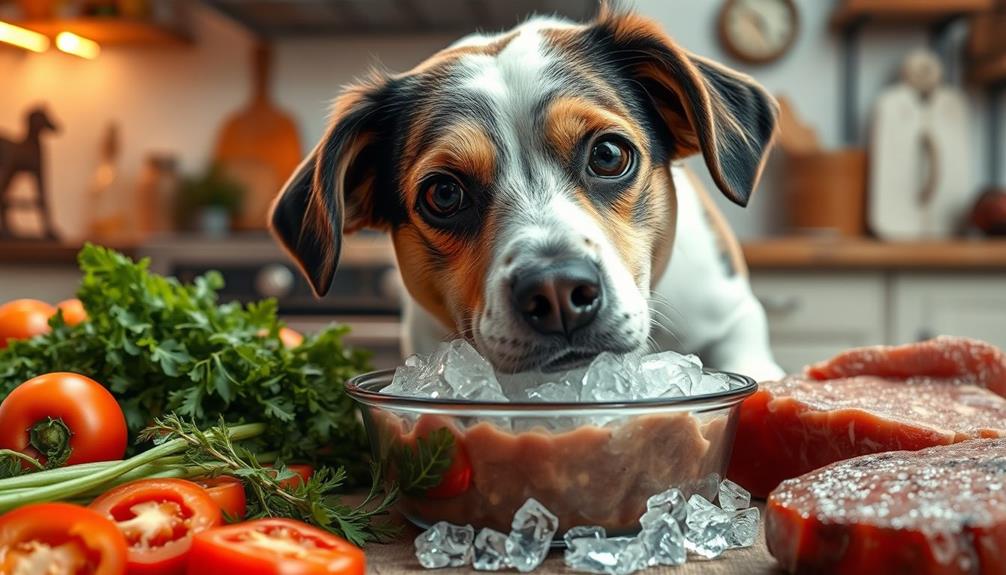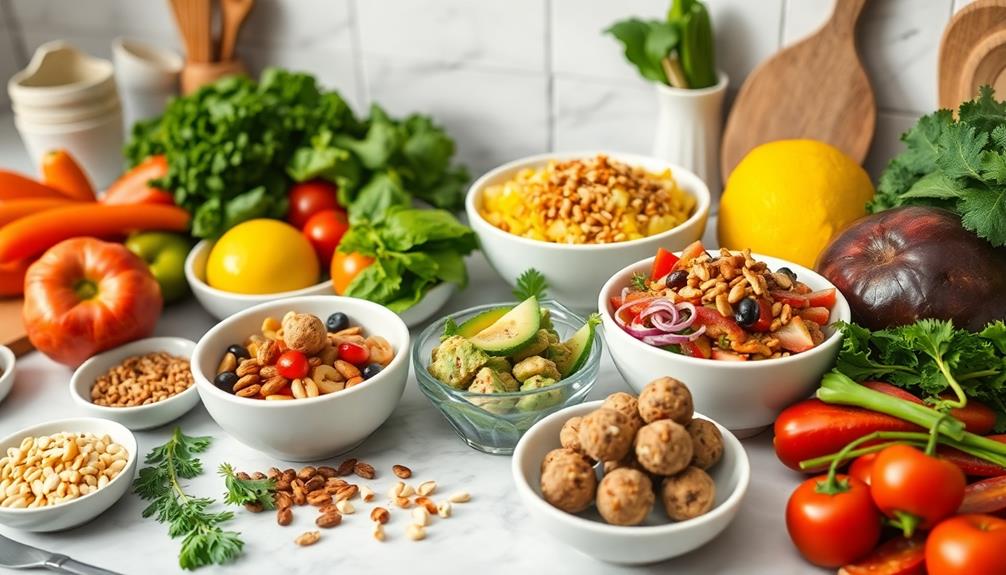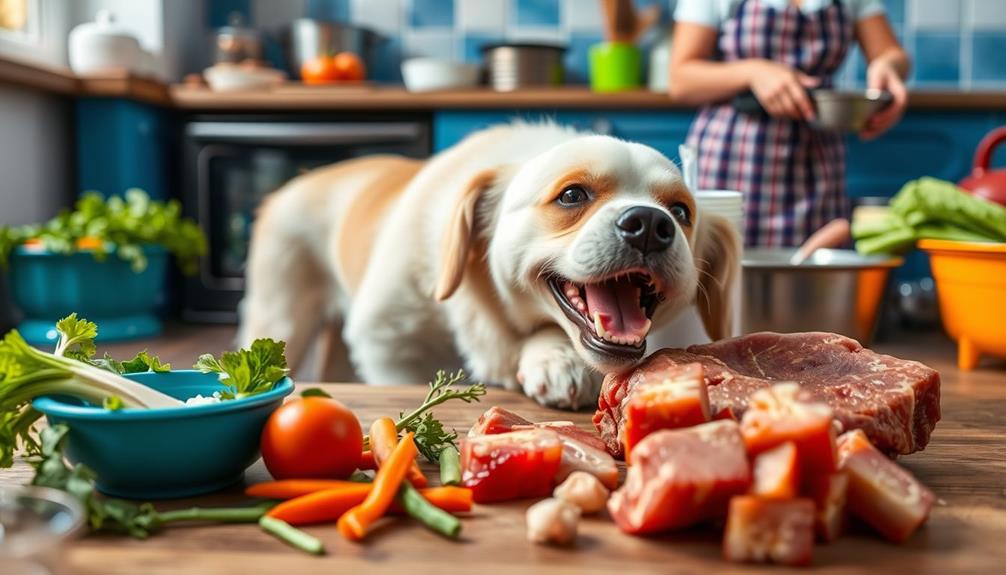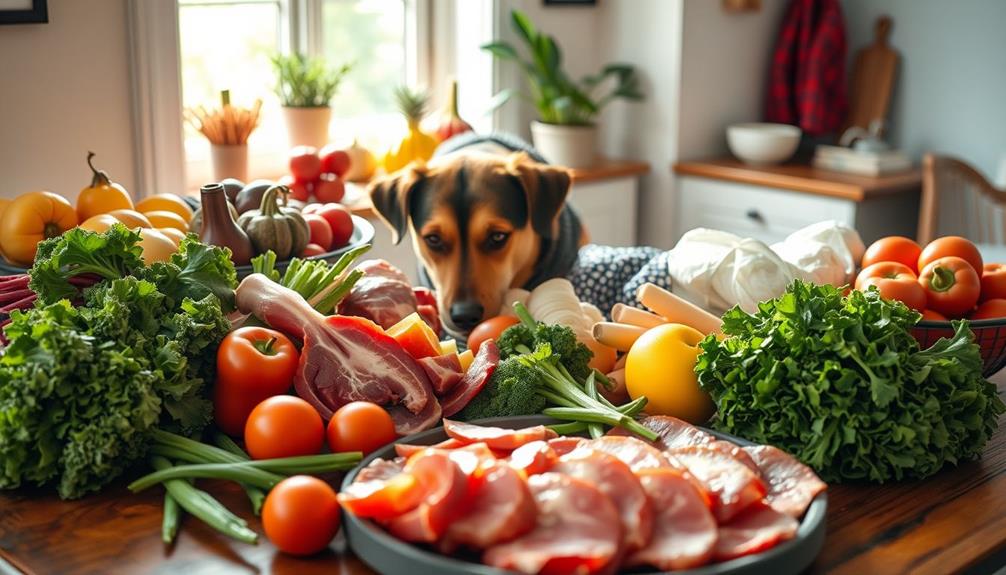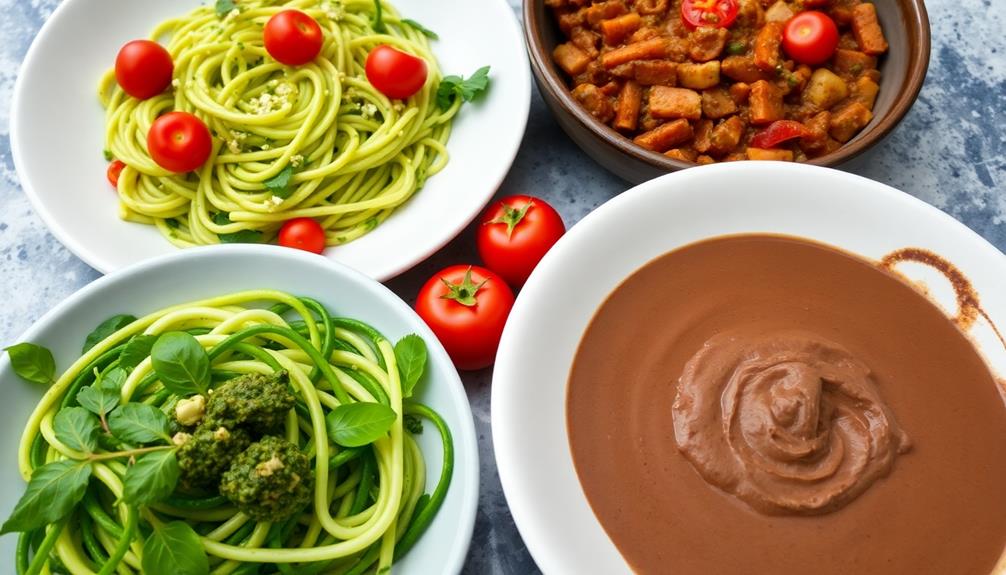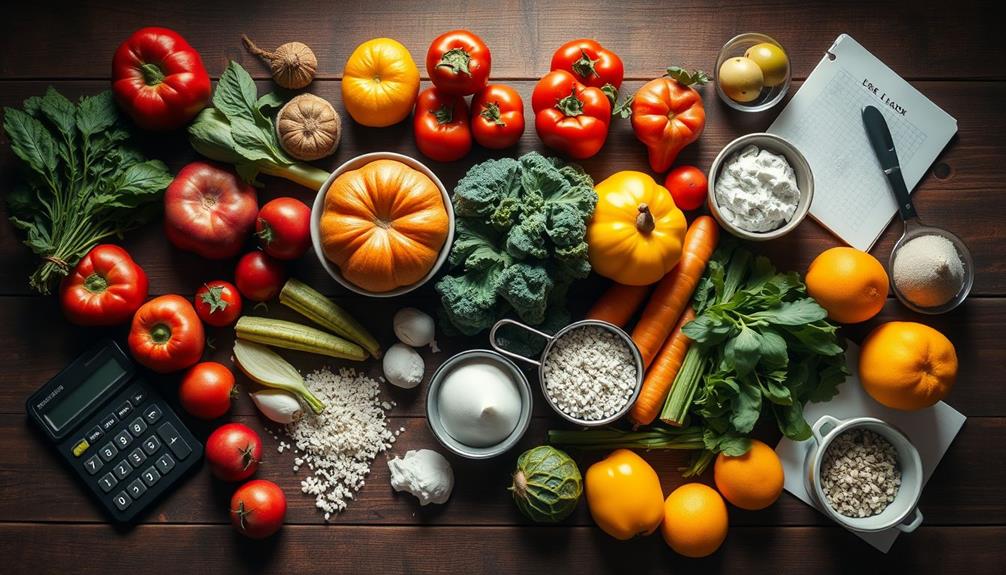Yes, your dog can eat frozen raw food, but it's vital to handle it safely. Frozen raw diets can enhance your pet's health and provide necessary nutrients, but improper thawing and handling can lead to bacterial risks. Always thaw food in the refrigerator and avoid leaving it at room temperature. Introduce the diet gradually over 7-10 days to prevent digestive issues. Be aware of toxic human foods and practice good hygiene after handling raw food. Checking with your vet about specific dietary needs and any potential risks can help guarantee your dog stays healthy on a raw diet. There's much more to take into account!
Key Takeaways
- Frozen raw food can be safely fed to dogs if proper thawing and handling practices are followed to minimize bacterial risks.
- Gradual transition over 7-10 days is recommended to prevent digestive issues when introducing frozen raw food.
- Portion control is essential; adjust based on your dog's needs and activity levels to maintain health.
- Always consult your veterinarian before starting a raw diet to assess dietary suitability and nutritional balance for your dog.
- Disinfect surfaces and practice good hygiene after handling raw food to prevent cross-contamination and protect household members.
Understanding Frozen Raw Food
Frozen raw food for dogs offers a unique way to provide your pet with a diet that mirrors their ancestral eating habits. This type of diet typically consists of uncooked meats, bones, fruits, and vegetables, designed to deliver balanced nutrition.
Unlike typical commercial pet foods, frozen raw diets maintain the nutritional integrity of the ingredients through advanced flash freezing technology, guaranteeing freshness. Additionally, it's important to verify that any food given to dogs is safe and healthy, much like how safe snacks for hamsters require careful selection.
When considering shifting to frozen raw food, it's vital to do so gradually over 7-10 days. Start by mixing the new food with their current diet to avoid any digestive issues. The health benefits of raw food diets can be significant, but proper food handling is essential to minimize risks.
To prevent bacterial contamination, always follow safety precautions when storing and thawing frozen raw food. Keep the food in a dedicated freezer and make sure it's thawed in the refrigerator, not at room temperature.
Nutritional Benefits for Dogs
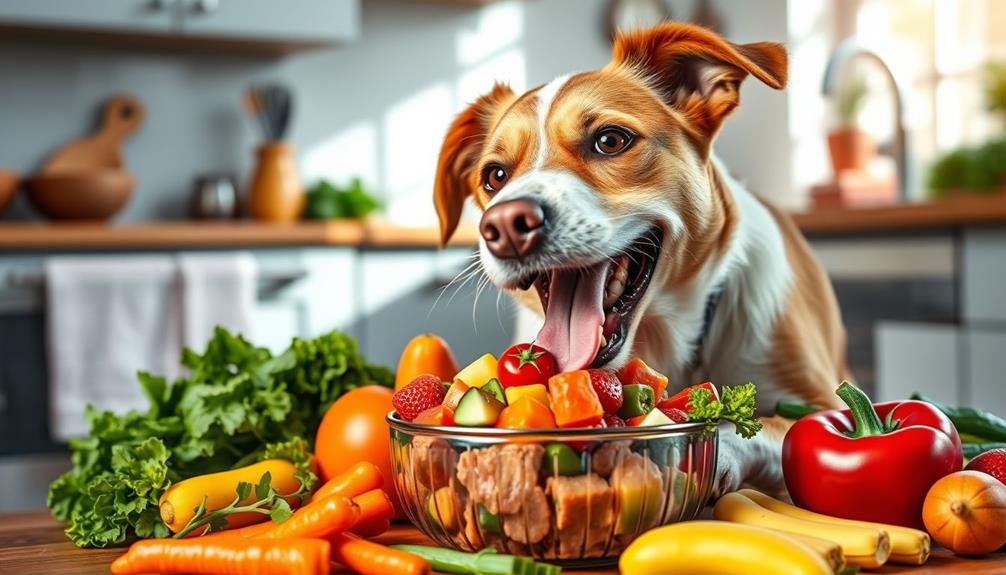
Choosing frozen raw food for your dog can lead to significant nutritional benefits that enhance their overall health. Raw diets often mirror the ancestral eating habits of canines, which can result in healthier body conditions and increased energy levels. These diets are typically high in protein, helping your dog maintain a healthy weight while providing the energy they need to thrive.
Moreover, frozen raw food can be rich in antioxidants, similar to the benefits of Cranberry Juice Consumption, which may help support your dog's immune system.
One of the key nutritional benefits of frozen raw food is its ability to improve immune function. These diets usually contain higher levels of antioxidants compared to processed options, contributing to better overall health.
Additionally, proprietary frozen raw food formulas often include a variety of protein sources, ensuring balanced nutrition tailored to your dog's needs.
The Biologically Appropriate Raw Food (BARF) diet promotes natural nutrition by incorporating raw meats, bones, fruits, and vegetables. This diverse nutrient profile supports your dog's health, making it easier for you to provide them with the essential nutrients they require.
Safety Precautions for Feeding
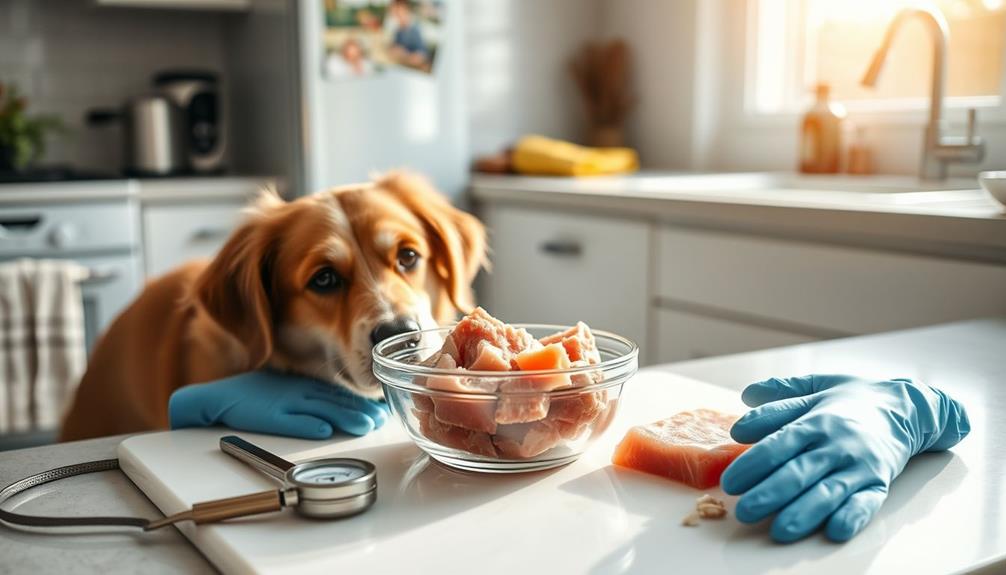
When it comes to feeding your dog frozen raw food, safety is key.
You'll want to follow proper thawing techniques, practice portion control, and handle the raw food carefully to prevent any health risks.
Additionally, it's vital to be aware of common types of cold medications that might pose risks if ingested by pets.
Let's break down these essential precautions to keep both you and your pup safe.
Handling Raw Food Safely
To safely handle raw food for your dog, always thaw it in the refrigerator or with warm water, guaranteeing you never leave it out at room temperature for more than two hours. This practice helps prevent bacteria in raw food from multiplying, reducing the risk of foodborne illnesses.
After feeding raw food, wash your hands with soap and water to avoid transferring harmful pathogens to yourself or other surfaces. Additionally, using a vacuum with a HEPA filter can aid in maintaining a clean environment by capturing allergens and bacteria that may be present in your home, making it safer for both you and your pet best HEPA filter vacuums.
You should also disinfect all surfaces that come into contact with raw meat to minimize the risk of cross-contamination with bacteria like Salmonella and Listeria.
It's wise to avoid direct contact with your pets immediately after feeding them raw food, particularly if anyone in your household is vulnerable to infections.
Be aware of toxic human foods that could harm your dog. Always guarantee any scraps you give them don't include dangerous ingredients like chocolate, grapes, or onions.
Thawing Techniques to Follow
Thawing frozen raw food properly is essential for keeping your dog safe from harmful bacteria. The best method is to thaw in the refrigerator, which takes about 24-36 hours and minimizes bacteria growth. Quick thawing techniques, like submerging the food in warm water, can work but need close monitoring to avoid temperature abuse. Never thaw raw food at room temperature, as this promotes the growth of dangerous pathogens.
Once thawed, you can keep the raw food in the refrigerator for up to two days. Dispose of any leftovers after this period to prevent spoilage. Always remember to wash your hands and disinfect surfaces after handling raw food to reduce the risk of cross-contamination.
| Thawing Method | Time Required | Safety Precautions |
|---|---|---|
| Refrigerator | 24-36 hours | Prevents bacteria growth |
| Warm water | Quick | Monitor closely to avoid temperature abuse |
| Room temperature | Not recommended | Promotes harmful bacteria growth |
Portion Control Guidelines
Portion control is vital for maintaining your dog's health and well-being, especially when feeding frozen raw food. Each package of frozen raw dog food includes portioning guidelines that act as a helpful starting point. You can adjust these portions based on your dog's individual needs and activity levels.
Incorporating essential items into your dog's diet can further enhance their nutritional intake. Remember, proper hydration is critical, so always provide fresh water at mealtime and throughout the day.
When feeding your dog thawed raw patties, keep food safety in mind. Thawed patties can stay in the refrigerator for up to two days, but any leftovers should be discarded to prevent foodborne illnesses. It's also important not to leave raw food out for more than two hours to minimize bacterial growth.
If you're new to raw diets, consider a gradual changeover period of 7-10 days. This method helps avoid digestive issues by mixing the new frozen raw dog food with your dog's current diet in increasing ratios.
Transitioning to a Raw Diet
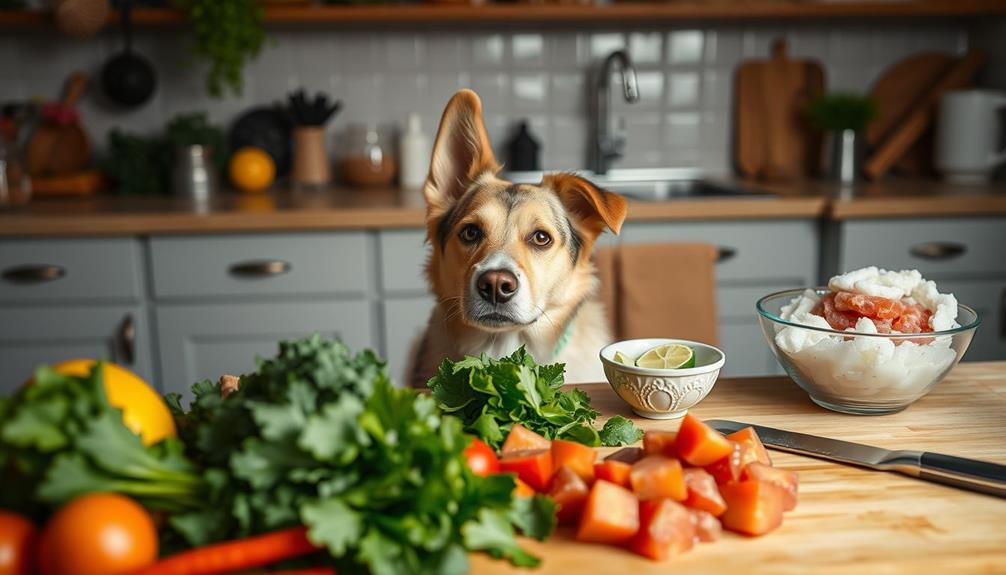
Shifting your dog to a raw diet can feel like a culinary adventure for both of you. To make this change successful, it's crucial to do it gradually over 7-10 days. Start by mixing frozen raw food with your dog's current diet, slowly adjusting the ratios. This approach helps prevent digestive issues and reduces the risk of gastrointestinal upset.
It's noteworthy that just like newborn bowel movement frequency, each dog's digestive system responds differently to dietary changes.
As your dog gets accustomed to the new food, familiarize them with its smell, taste, and texture. This can encourage acceptance and ease any apprehensions they might've about the change. Remember, sudden shifts in diet can lead to temporary discomfort, so take your time with this process.
Each package of frozen raw food usually comes with portioning guidelines, making it easier to determine the right serving size for your dog.
During the change, closely monitor your dog's response to the new diet. If you notice any adverse reactions or persistent digestive issues, don't hesitate to consult a veterinarian for advice.
With patience and attention, you'll help your furry friend embrace their new raw food diet!
Risks and Considerations
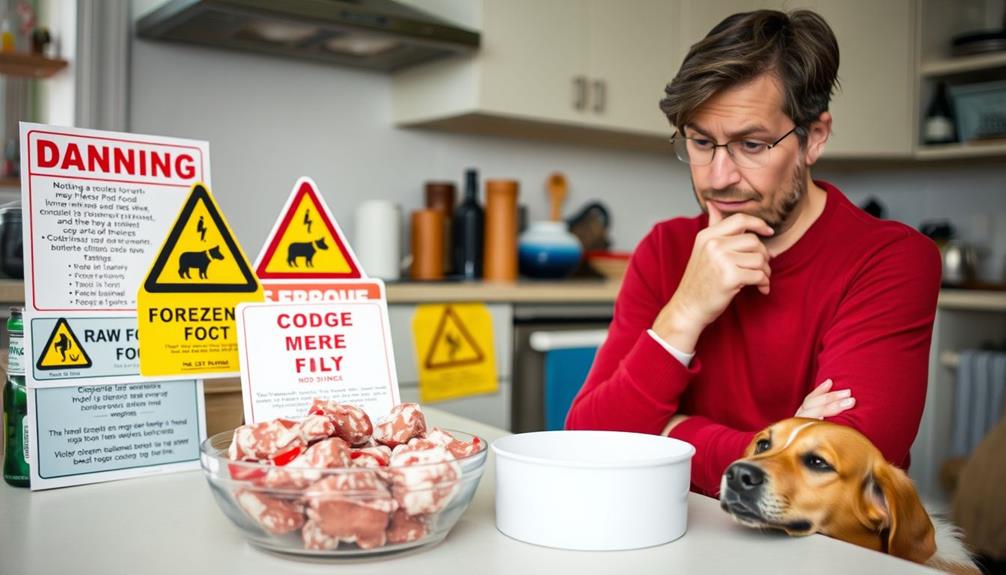
When you decide to incorporate frozen raw food into your dog's diet, it's important to keep in mind the potential risks and considerations involved. Frozen raw pet foods can carry foodborne pathogens like Salmonella and Listeria, posing health risks not just to your dog but also to you and your family.
To minimize these risks, it's important to handle raw food carefully. The CDC recommends freezing raw meat to kill parasites and thawing it in the refrigerator to reduce bacterial growth. Additionally, ensuring proper hygiene in your kitchen is crucial, as you'd want to avoid contamination similar to how you'd maintain air purifier maintenance dos and don'ts with your home appliances.
You also need to be vigilant about cross-contamination. Disinfect surfaces that come into contact with raw food, especially if you have vulnerable individuals in your home.
Additionally, raw diets may lead to nutritional deficiencies if they aren't properly balanced. Many commercial raw diets require supplementation to meet your dog's dietary needs.
Consulting Your Veterinarian
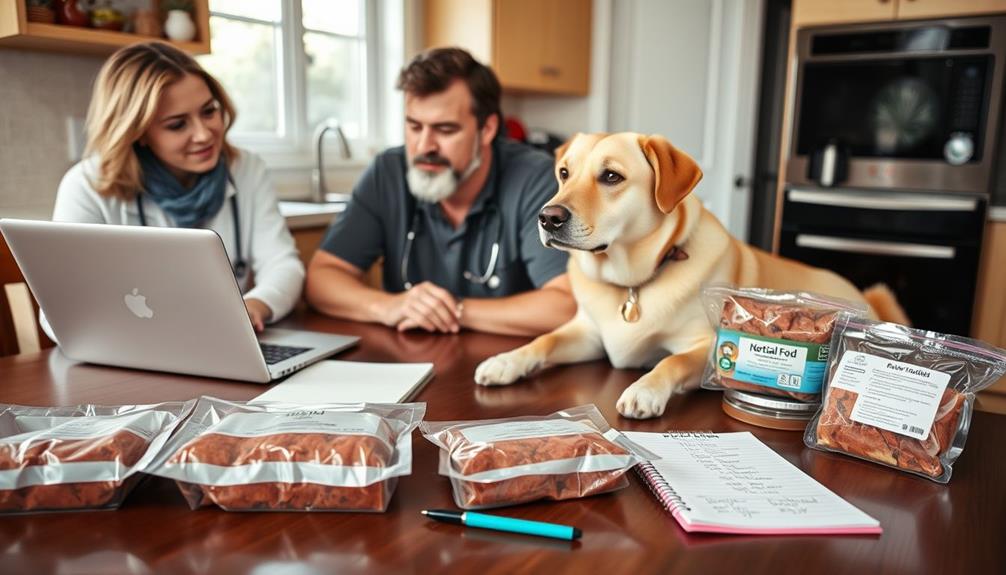
Before you introduce frozen raw food into your dog's diet, it's wise to consult your veterinarian. A vet can help assess the potential health risks and dietary needs specific to your pet.
Discussing your dog's health history is essential, as certain existing conditions may make feeding a raw diet inadvisable. Additionally, understanding the potential implications of a raw diet on your dog's overall health and well-being is important, especially considering financial considerations for elderly care in case of health complications.
Veterinarians can provide valuable insights on the nutritional balance of raw food diets. Many homemade or unregulated raw food options can lead to deficiencies, which could harm your dog's health in the long run.
The American Veterinary Medical Association generally advises against raw diets due to concerns about bacteria and nutritional imbalances that may arise from improper feeding practices.
Popular Myths Debunked
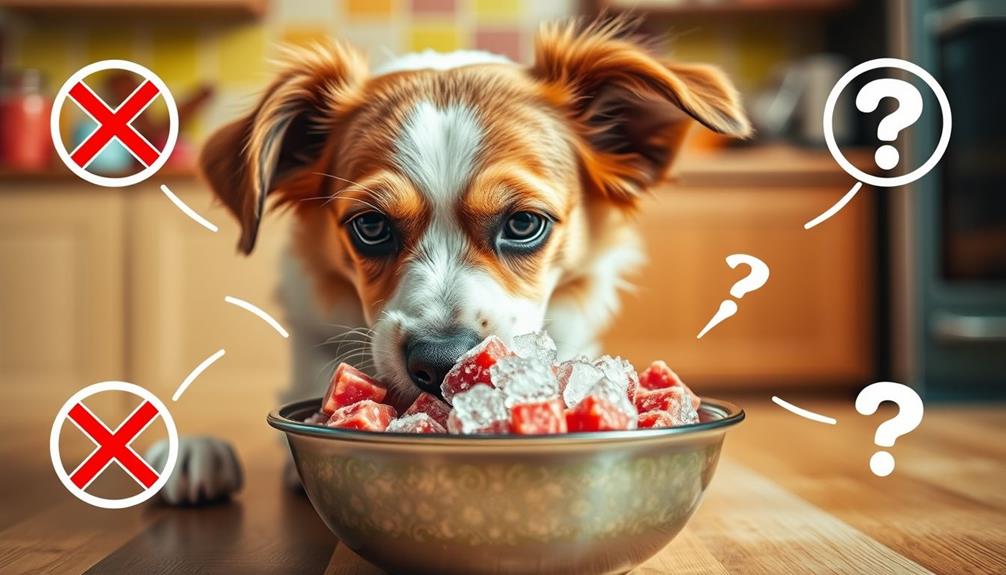
When it comes to raw diets, many myths can cloud your judgment. You might think that frozen raw food is always safe and nutritionally complete, but that's not the full picture.
It's crucial to take into account factors such as proper nutrient balance and potential contamination risks, which can impact your dog's health.
Additionally, understanding credit score implications can help you manage your finances better when investing in quality pet food.
Let's break down these misconceptions to guarantee you make the best choices for your dog's health.
Raw Food Safety Concerns
Many dog owners worry about the safety of feeding their pets raw food, often fueled by common myths. While it's true that a raw meat diet can carry risks, the actual chance of infection is quite low, at just 0.24%. However, this doesn't mean you can be lax about raw food safety.
Thawed raw food can still harbor pathogenic bacteria, so strict food handling practices are vital. Always thaw meat in the refrigerator or with warm water to minimize bacterial growth. It's also important to note that dogs can have certain treats like vanilla ice cream in moderation, but this shouldn't replace their balanced diet or raw food intake. pet-friendly ice creams are specifically formulated to be safe for canine consumption.
Concerns about raw bones often arise due to choking hazards. While raw bones can pose risks, they're generally safer than cooked bones, which can splinter and cause serious injuries.
Additionally, many veterinary associations caution against raw diets due to potential nutritional imbalances and the risk of bacterial transmission to humans through improper handling of raw meat.
To keep your furry friend safe, focus on proper thawing techniques and hygiene. By being mindful of these factors, you can help guarantee that your dog enjoys their raw food safely and healthily.
Nutritional Myths Explained
Over the years, various myths have emerged regarding the nutritional benefits of frozen raw food diets for dogs. It's easy to see why pet owners might feel drawn to these diets, but understanding the facts is vital for your dog's health.
Here are three popular myths you should be aware of:
- Raw diets mimic ancestral diets: While it seems logical, achieving nutritional balance in raw diets is tricky without expert guidance, risking deficiencies.
- Health benefits are guaranteed: A study from Cambridge University found that 60% of dogs on raw diets faced nutritional imbalances, debunking the idea that raw food is inherently healthier.
- All dogs thrive on raw meat: Different breeds and health issues mean that raw diets aren't one-size-fits-all. Tailored nutritional advice is essential.
While some claim frozen raw food leads to shinier coats and better dental health, these benefits can arise from high-fat compositions without needing raw diets.
Plus, despite freezing, there's still a risk of bacterial contamination. Always consult your vet before making any changes to your dog's diet to avoid health problems.
Frequently Asked Questions
Is It Okay to Feed Dogs Frozen Raw Food?
Feeding your dog frozen raw food can be risky. It's essential to thaw it properly to avoid choking hazards. Always consult your vet to guarantee your dog's diet is balanced and safe from potential bacteria.
How Do You Prepare Frozen Raw Food for Dogs?
To prepare frozen raw food for your dog, thaw it in the refrigerator for 24-36 hours. Always use clean hands and utensils, and don't refreeze leftovers after two hours to guarantee safety.
Does Raw Dog Food Need to Be Fully Defrosted?
Raw dog food doesn't need to be fully defrosted, but serving it frozen is like throwing a snowball at your pup—it's a choking hazard! Guarantee it's thawed enough to be safe and digestible.
How Much Frozen Raw Food Should I Feed My Dog?
To determine how much frozen raw food to feed your dog, start with the recommended guidelines, typically 2-3% of their ideal body weight daily, adjusting based on age, size, and activity level. Monitor their condition regularly.
Conclusion
Feeding your dog frozen raw food can be a game-changer for their health, but it's vital to approach it with caution. While the nutritional benefits can lead to a vibrant, energetic pup, the risks of improper handling can be alarming. Balancing these elements is important—think of it as a dance between nourishment and safety. By educating yourself and consulting your vet, you can confidently decide whether this diet suits your furry friend's needs.

